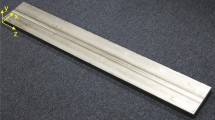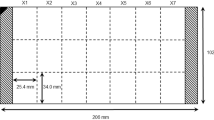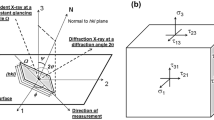Abstract
Background
There are various experimental measurement techniques used to measure residual stress and this work describes one such method, the slotting method, and its application to measure near surface residual stresses.
Objective
This work examines its application to macro-scale specimens.
Methods
A series of numerical experiments were performed to understand the size required to assume that the specimen is infinitely large, namely the thickness, width, and height. To assess measurement repeatability, 12 slotting measurements were performed in a shot peened aluminum plate.
Results
The numerical experiments determined the specimen should have a thickness greater than or equal to 21.6 mm (0.85 in), a total specimen width (normal to the slot length) greater than or equal to 44.5 mm (1.75 in), and total height (parallel to the slot) greater than or equal to 38.1 mm (1.5 in) for the specimen to be assumed to be infinite. Slotting measurement repeatability was found to have a maximum repeatability standard deviation of 30 MPa at the surface that decays rapidly to 5 MPa at a depth of 0.3 mm from the surface. Comparison x-ray diffraction measurements were performed.
Conclusions
Infinite plate dimensions and slot length were determined as well as measurement repeatability. Slotting was shown to have significantly better repeatability than X-ray diffraction with layer removal for this application.












Similar content being viewed by others
References
ASTM Standard E837–20 (2020) Standard Test Method for Determining Residual Stresses by the Hole-Drilling Strain-Gage Method, ASTM International, West Conshohocken, PA
Lord JD, Fry AT, Grant PV (2002) A UK Residual Stress Intercomparison Exercise - An Examination of the XRD and Hole Drilling Techniques, NPL Report MATC(A)98
MB Prime (1999) Residual stress measurement by successive extension of a slot: The crack compliance method. Appl Mech Rev. https://doi.org/10.1115/1.3098926
Hill MR (2013) The Slitting Method. In GS Schajer (Ed.), Practical Residual Stress Measurement Methods pp. 89–108, John Wiley & Sons
Olson MD, DeWald AT, Hill MR (2019) An Uncertainty Estimator for Slitting Method Residual Stress Measurements Including the Influence of Regularization. Exp Mech. https://doi.org/10.1007/s11340-019-00535-x
Schajer GS, Prime MB (2006) Use of Inverse Solutions for Residual Stress Measurements. J Eng Mater Technol 128:375
Student Manual for Strain Gage Technology (Bulletin 3090) (1992) Vishay Measurements Group, Malvern, PA
Prevey PS (1986) X-ray diffraction residual stress techniques. ASM International, ASM Handbook 10:380–392
Hill MR, Olson MD (2014) Repeatability of the Contour Method for Residual Stress Measurement. Exp Mech 54(7):1269–1277. https://doi.org/10.1007/s11340-014-9867-1
Fry AT (2002) Evaluation of the Repeatability of Residual Stress Measurements Using X-Ray Diffraction, NPL Report MATC(MN)19
Lee MJ, Hill MR (2007) Intralaboratory Repeatability of Residual Stress Determined by the Slitting Method. Exp Mech 47
Acknowledgements
Portions of this work are protected by US Patent 10,900,768 and are patent pending for other international jurisdictions.
Author information
Authors and Affiliations
Corresponding author
Ethics declarations
Conflict of Interest
The authors have no conflicts of interest to disclose and did not involve human or animal participants nor was informed consent applicable.
Additional information
Publisher's Note
Springer Nature remains neutral with regard to jurisdictional claims in published maps and institutional affiliations.
Rights and permissions
About this article
Cite this article
Olson, M.D., Watanabe, B.T., Wong, T.A. et al. Near Surface Residual Stress Measurement Using Slotting. Exp Mech 62, 1401–1410 (2022). https://doi.org/10.1007/s11340-022-00858-2
Received:
Accepted:
Published:
Issue Date:
DOI: https://doi.org/10.1007/s11340-022-00858-2




